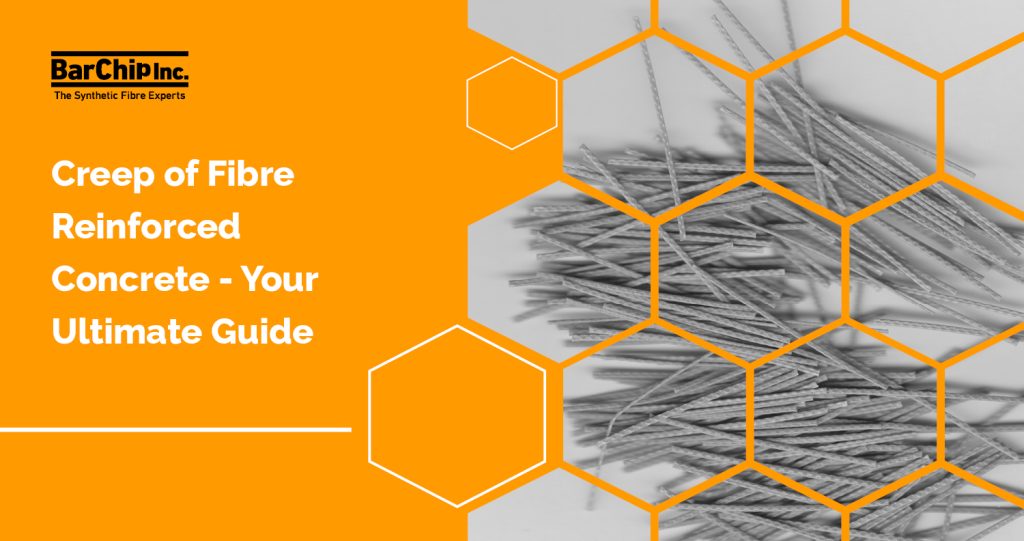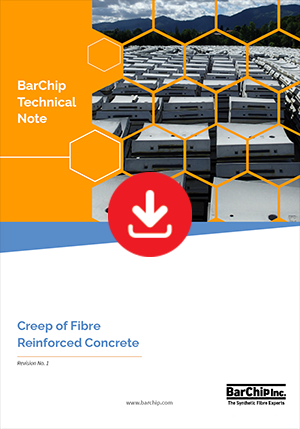11 Key Facts About Creep of Fibre Reinforced Concrete
1. What is Creep
Creep is a time-dependent increase in strain under sustained stress, impacting FRC in tension, compression, and shear. It can be a critical factor in the long term performance of concrete structures, influencing deflections, crack widths, and overall structural integrity.
2. What Causes Creep
Creep in concrete is primarily caused by the movement of moisture within calcium silicate hydrate (CSH) crystals in the cement paste. Other factors influencing creep include microcracking, aggregate type, temperature and humidity. Increased porosity in concrete allows for more moisture movement, contributing to time-dependent deformation.
3. Influence of Fibres on Creep
While fibres have little effect on the creep properties of concrete under compression, they can have a large role in post-crack tensile creep, which can increase crack widths and structural deformation over time.
4. Macro Synthetic vs. Steel FRC on Creep
Macro synthetic fibres typically exhibit larger tensile creep strains than steel fibres, possibly due to fibre elongation. However, high performance fibres like BarChip have been shown to perform as well as steel fibre in long term flexural creep testing. While steel fibres generally show lower creep strains, they must adhere to stricter crack width limits due the risk of corrosion.
5. The Four Elements of Creep Relevant to Structural Performance
The four critical aspects of creep in FRC related to structural performance are:
- Crack Width Increase: Time-dependent widening of cracks.
- Deflection of Suspended Structures: Creep-induced deflections in hybrid structures with fibres and steel reinforcement.
- Creep Rupture: Potential structural failure due to the time-dependent loss of structural continuity, particularly in structures using fibres as the sole reinforcement.
- Durability of Steel Reinforcement: The degree to which time dependent crack width increase can lead to corrosion and corrosion induced creep rupture.
- Download: Creep of Fibre Reinforced Concrete
- Download: The Role of Creep in the Behaviour of Selected Fibre Reinforced Concrete Structures
6. Creep Rupture
Creep rupture refers to the time-dependent failure of concrete under sustained load, particularly in suspended structures. This can occur due to the progressive pull-out of fibres or the snapping of fibres at cracks, leading to structural discontinuities.
7. The Influence of Fibres on Long-Term Crack Width in Creep
Creep research shows that both steel and macro synthetic fibres experience time-dependent increases in crack width and deflection, with macro-synthetic FRC generally exhibiting greater creep deformation over time. However, the performance within fibre classes can vary greatly, with some steel fibres allowing very large increases in crack width, and some macro synthetic fibres allowing minimal increases. Research has shown embossed BarChip macro synthetic fibres to be particularly effective in this regard.
8. Ductility vs. Creep Resistance in Steel Fibre Reinforced Concrete
Steel fibre reinforced concrete can either exhibit high ductility with fibres pulling out during crack widening, or strong resistance to creep when embrittled, but it can rarely achieve both properties simultaneously.
In steel fibre reinforced concrete (FRC), there is a trade-off between ductility and creep resistance. When the concrete matrix strength is tailored to allow fibres to pull out during crack widening, the material exhibits high ductility. However, if the concrete is too strong, leading to fibre rupture instead of pull-out, the mixture becomes embrittled, resulting in high resistance to creep and minimal crack width increase over time.
9. Creep Relaxation
Creep Relaxation in concrete, which involves the gradual dissipation of stress under constant strain, plays a key role in preventing cracking by redistributing loads and reducing long-term crack widths, especially in young concrete. While both steel and macro-synthetic fibre reinforced concretes exhibit relaxation, the extent of this effect is significantly reduced in embrittled mixtures with high matrix strength, where fibre pull-out is minimized, retaining more load resistance over time.
10. Serviceability and Long-Term Performance as a Result of Creep
As creep causes crack widths to increase over time, the risk of corrosion grows, rapidly diminishing the structural effectiveness of steel fibres because of corrosion. This results in the need for strict crack width limits to ensure the durability and longevity of steel fibre reinforced concrete, particularly in aggressive environments. Macro synthetic fibres are not affected by corrosion, and structurally are not restricted by low crack width limits.
11. Creep in the Real World vs. Creep in Simple Beams
The extent of deformation due to creep is often less in real world structures than in simply supported beams (as are typically used in laboratory tests) because real structures are typically redundant, allowing for load redistribution. Accounting for the creep behaviour of all parts of a structure is necessary for accurate long-term performance predictions.



